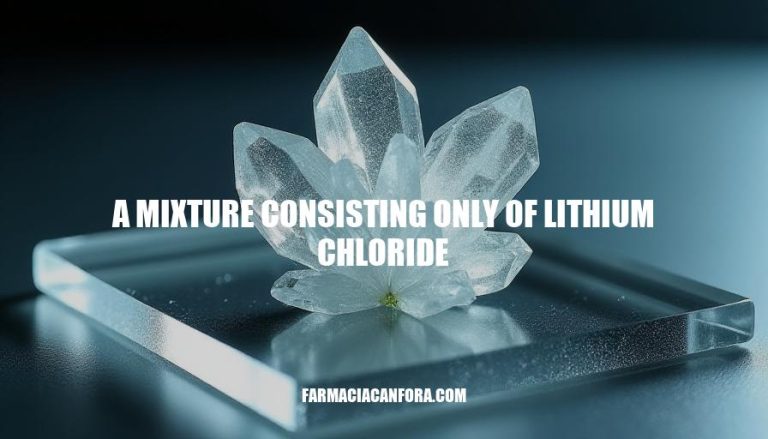


Lithium chloride (LiCl) is a binary salt compound composed of lithium and chlorine atoms. The lithium ion (Li⁺) and the chloride ion (Cl⁻) combine to form an ionic bond, resulting in a crystalline structure. Lithium chloride is a white, hygroscopic solid with a molar mass of approximately 42.39 g/mol.
It has high solubility in water and exhibits deliquescent properties, meaning it can absorb moisture from the air until it dissolves into an aqueous solution. LiCl has a melting point of around 614°C and a boiling point of approximately 1382°C. Commonly used in various applications such as in air conditioning systems as a desiccant, in the production of lithium metal, and in organic synthesis as a catalyst or reagent.
Its ability to lower the freezing point of water also makes it useful in certain industrial processes.
Lithium chloride (LiCl) is composed of lithium ions (Li⁺) and chloride ions (Cl⁻), forming an ionic bond in a crystal lattice structure. Its molecular weight is approximately 42.39 g/mol. LiCl is highly soluble in water, with a solubility of about 83.05 g per 100 mL at 20°C.
This high solubility is due to the strong ionic interactions between the lithium and chloride ions with water molecules.
In terms of reactivity:
With water: LiCl dissolves readily, dissociating into Li⁺ and Cl⁻ ions.
With oxygen: Lithium chloride can form lithium oxide (Li₂O) when reacting with oxygen at high temperatures.
With sulfuric acid (H₂SO₄): Forms lithium sulfate (Li₂SO₄) and hydrochloric acid (HCl).
With sodium carbonate (Na₂CO₃): Produces lithium carbonate (Li₂CO₃) and sodium chloride (NaCl).
LiCl also demonstrates hygroscopic properties, meaning it readily absorbs moisture from the air, which is useful for certain applications like drying agents. Let’s keep exploring!
To prepare a mixture consisting only of lithium chloride in a laboratory or industrial setting, several methods can be employed, each requiring precision and high purity:
Direct Synthesis: Lithium chloride can be synthesized by reacting lithium carbonate (Li2CO3) with hydrochloric acid (HCl). The reaction produces lithium chloride and carbon dioxide gas. The resulting lithium chloride is then purified through recrystallization to achieve the desired purity.
Solvometallurgical Process: This method involves dissolving lithium chloride in an ethanol-based solution.
The solution is then treated to selectively precipitate impurities such as magnesium and calcium hydroxides, leaving behind high-purity lithium chloride. This process requires precise control of temperature and solvent composition to ensure the selective dissolution and precipitation of impurities.
Evaporation and Crystallization: In this method, a lithium-containing brine is concentrated through evaporation. The concentrated brine is then cooled to precipitate lithium chloride crystals.
The crystals are separated from the remaining solution and further purified through recrystallization. This method requires careful control of evaporation rates and cooling conditions to achieve high-purity lithium chloride.
Ion Exchange: This technique involves passing a lithium-containing solution through an ion exchange resin that selectively removes impurities. The purified lithium chloride solution is then concentrated and crystallized to obtain high-purity lithium chloride.
Precision in the choice of ion exchange resin and control of flow rates is crucial for achieving the desired purity.
Vacuum Distillation: For extremely high-purity lithium chloride, vacuum distillation can be employed. The lithium chloride is heated in a vacuum to evaporate and then recondensed, leaving behind impurities. This method requires precise control of temperature and vacuum conditions to ensure the removal of all impurities.
Each of these methods requires meticulous attention to detail, precise control of reaction conditions, and rigorous purification steps to achieve the high purity required for lithium chloride in various applications, such as battery manufacturing and other industrial uses.
Lithium chloride (LiCl) is a versatile compound with several practical applications across various industries:
Electrolyte in Batteries: Lithium chloride is used as an electrolyte in lithium-ion and lithium-metal batteries. It helps in the movement of lithium ions between the anode and cathode, enabling the storage and delivery of electrical energy.
Desiccant: Lithium chloride is employed as a desiccant in pharmaceuticals to absorb moisture and keep products dry.
Anti-inflammatory Agent: It has anti-inflammatory properties and is used in the treatment of certain inflammatory diseases.
Organic Synthesis: In organic chemistry, lithium chloride serves as a reagent or catalyst in various synthesis processes.
Heat Storage and Cooling: Due to its high heat capacity, lithium chloride is used in heat storage and cooling applications.
Metallurgy: It is used as a flux in welding and soldering processes, and in the production of lithium metal.
Dehumidification: Lithium chloride is used in dehumidification systems, such as air conditioning, due to its hygroscopic properties.
Flame Colorant: It is used as a flame colorant to produce dark crimson flames.
Biological Applications: Lithium chloride is used in the precipitation of RNA in biological research.
These applications highlight the wide-ranging utility of lithium chloride in various industrial and scientific fields.
Wear protective gloves/eye protection. Ensure adequate ventilation. Avoid contact with skin, eyes, or clothing.
Store in a cool, well-ventilated place. Keep away from food, drink, and animal feed. Use suitable respirator when high concentrations are present.
Avoid dust formation. Keep people away from and upwind of spill/leak. In case of fire, use appropriate extinguishing media.
Rinse skin with water/shower if contact occurs. Irrigate eyes with clean, fresh water for at least 10 minutes if contact occurs. Seek medical advice if symptoms persist.
Dispose of contaminated clothing and clean affected areas thoroughly.
Lithium chloride (LiCl) is a binary salt compound composed of lithium and chlorine atoms, forming an ionic bond in a crystal lattice structure. It has high solubility in water, with a melting point of around 614°C and a boiling point of approximately 1382°C. LiCl is highly reactive, dissolving readily in water and reacting with oxygen to form lithium oxide, sulfuric acid to produce lithium sulfate and hydrochloric acid, and sodium carbonate to produce lithium carbonate and sodium chloride.
The compound has various applications across industries, including:
Lithium chloride is also used in:
In terms of safety precautions, it is essential to: